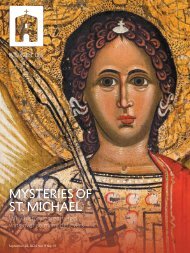Angelus News | September 23, 2022 | Vol. 7 No. 19
On the cover: The logo used for the Catechism of the Catholic Church, published in 1992, is adapted from an image found in the Catacombs of Domitilla in Rome thought to symbolize “the rest and the happiness that the soul of the departed finds in eternal life.” Ahead of the 30th anniversary of the catechism’s release next month, Russell Shaw explains on Page 10 what prompted the Church to undertake such an immense project. On Page 26, Greg Erlandson offers a perspective on the text’s relevance to ordinary Catholics — like his own mother.
On the cover: The logo used for the Catechism of the Catholic Church, published in 1992, is adapted from an image found in the Catacombs of Domitilla in Rome thought to symbolize “the rest and the happiness that the soul of the departed finds in eternal life.” Ahead of the 30th anniversary of the catechism’s release next month, Russell Shaw explains on Page 10 what prompted the Church to undertake such an immense project. On Page 26, Greg Erlandson offers a perspective on the text’s relevance to ordinary Catholics — like his own mother.
You also want an ePaper? Increase the reach of your titles
YUMPU automatically turns print PDFs into web optimized ePapers that Google loves.
DESIRE LINES<br />
HEATHER KING<br />
Making music to die for<br />
Elaine Stratton Hild. | COURTESY IMAGE<br />
When Elaine Stratton Hild,<br />
Ph.D., was only 18 years old<br />
and a music conservatory<br />
student, she was volunteering at a local<br />
hospital, playing the viola. One day<br />
she was directed to the room of a particular<br />
woman who was very ill. She<br />
started playing “Amazing Grace” and<br />
in the course of the song, the woman<br />
died.<br />
“Did I do something wrong?” she<br />
asked the hospital staff. “<strong>No</strong>,” she was<br />
told. “You didn’t do anything wrong.<br />
That woman rode your hymn right up<br />
to heaven.”<br />
She went on to earn a bachelor’s<br />
degree in music in viola performance<br />
from the Cleveland Institute of Music.<br />
Then, poised for a career with orchestras<br />
and chamber music ensembles,<br />
she was diagnosed with a rare neurological<br />
condition. Continuing to<br />
play professionally would have meant<br />
possible paralysis in her left hand.<br />
As difficult as it was to change course,<br />
the diagnosis allowed Hild to embark<br />
on a more academic career. She<br />
earned both a master’s degree and a<br />
Ph.D. in musicology from the Univer-<br />
sity of Colorado at Boulder.<br />
And in 2018, she was a Distinguished<br />
Fellow at the University of <strong>No</strong>tre<br />
Dame’s Institute for Advanced Study, a<br />
semester-long fellowship during which<br />
she conducted full-time research on<br />
a fascinating and specialized area: the<br />
chants sung for the dying during the<br />
Middle Ages.<br />
She currently serves as a musicologist<br />
with Corpus Monodicum, a long-term<br />
research project housed at the Universität<br />
Würzburg (Germany) focused on<br />
historically significant monophonic<br />
church and secular music of the European<br />
Middle Ages.<br />
“There’s an entire repertory of<br />
plainchant that historians haven’t<br />
dealt with: a collection of works that<br />
were meant to be sung, in community,<br />
around the bedside of a person who’s<br />
about to leave this world.”<br />
Studying archival music in Europe allowed<br />
Hild to see the deathbed not so<br />
much as an end but an opening — a<br />
sacred time during which music could<br />
play a beautiful and important part.<br />
A forthcoming book has the working<br />
title “Song At the Moment of Death:<br />
Chants and Medieval Rituals for the<br />
End of Life.” And she runs a small<br />
business, Palliative Music, dedicated<br />
to providing comfort music for people<br />
in the Fort Collins, Colorado, area<br />
experiencing difficult medical circumstances<br />
and end-of-life care.<br />
In her work with the suffering and dying,<br />
Hild plays the viola and the harp.<br />
She also sings. “The more fragile, the<br />
closer to death, the more gentle the<br />
sounds have to be. Sometimes the<br />
human voice is the simplest instrument.<br />
So sometimes that feels most<br />
appropriate.”<br />
Her fervent wish is that we might all<br />
come to play music, chant, or sing<br />
around the bedside of our loved ones<br />
at such moments.<br />
“Interestingly, the historic material<br />
I study was not for professionals. It’s<br />
made very clear that the chant was<br />
for the community. I’m all in favor of<br />
medical resources and experts. But<br />
death is a human experience, not just<br />
a medical experience.”<br />
So maybe one thing these chants are<br />
telling us is that a deathbed is not the<br />
place for the professionals. “Maybe it’s<br />
30 • ANGELUS • <strong>September</strong> <strong>23</strong>, <strong>2022</strong>


















